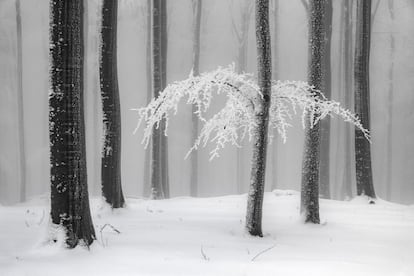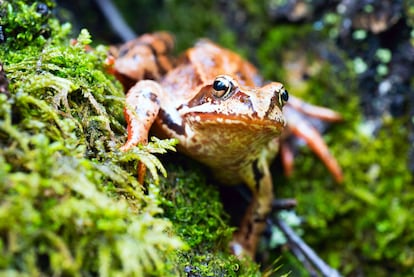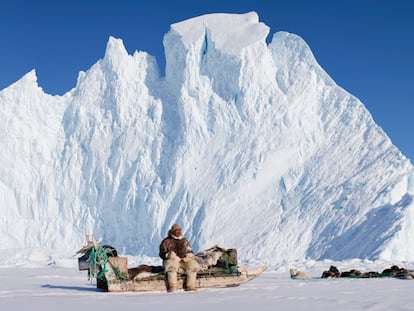The subnivium: A secret world under the snow that’s full of life
In the northern hemisphere, the ecosystem that forms between the snowpack and the ground is a winter home for many organisms

Every winter, snow covers a large part of the northern hemisphere – its mantle can extend over 25 million miles. When conditions are right, it creates a vast but ephemeral ecosystem called the subnivium, the small area that forms between the snowpack and the ground. The space is so thermally insulated that it can remain stable at around 0°C for weeks, even if outside temperatures fall below 20° or 30° below zero (-4°F or -22°F).
For this to happen, a not-too-dense layer of snow – around eight inches thick – needs to form. The lighter and fluffier the layer, the better, as this increases the area’s capacity for insulation. As the snow settles on the earth, the warm air on the ground rises, converting the deeper layers of snow into air vapor. When it condenses, it freezes to form the icy ceiling of a small space, a few inches above the ground. The subnivium is an extensive and complex ecosystem of small caves and corridors of thin ice that provide shelter for plants and animals. Many species depend on the formation of these caves and corridors to survive the harsh northern winters.
Throughout the winter, one can find beetles, springtails, spiders and even different types of flies active in the subnivium. It doesn’t matter that the temperatures outside have dropped below zero degrees or that strong gusts of icy wind are blowing. Underneath the snow, it is as if winter had stopped. There is no wind, and the temperature remains stable; it hovers around the freezing point. This area is not a dark place; so much light can filter through the snow that mosses and evergreen shrubs continue to photosynthesize. Some plants even flower under the snow. Shrews and mice also move under the subnivium’s vaulted tunnels. Weasels, too, can easily wander into them to chase rodents, while foxes and wolverines may dive into the snow to curl up in the subnivium’s warmer bases.

Frogs may hibernate and wait for better times among the fallen leaves captured under the snow. A number of frogs in North America stand out for their extreme adaptation to the cold. While most frogs survive winters by hibernating deep in lakes or streams – where temperatures never drop below freezing – other frogs follow a radically different strategy.
For example, when winter comes, the wood frog (Lithobates sylvaticus) nestle into the fallen leaves under the subnivium to protect itself from extreme temperatures; however, they must still face freezing temperatures. These frogs become little more than ice cubes for days at a time. Two-thirds of the water in the frogs’ bodies can freeze without causing damage. Surviving being frozen is not normal. We are still far away from being able to freeze ourselves for intergalactic travel, although perhaps we can learn something from these frogs. When a body freezes, ice crystals form and perforate the blood vessels and the cells dehydrate, fracturing the cell walls and dismantling their inner structure. Once the blood has frozen, there is no way to transport oxygen and nutrients to the vital organs. For the vast majority of animals, frostbite causes immense damage to the internal organs and death. But some frogs are able to avoid that fate; they can be frozen for up to eight months and then come back to life in the spring.

How do they do that? With the onset of cold weather, the frogs produce large quantities of glucose in the liver. This sugar solution concentrates inside the cells, acting as a sort of antifreeze that prevents the cells from dehydrating and keeps ice from forming inside them. But the bloodstream is loaded with nucleoproteins that enhance ice formation, so when temperatures fall below freezing, the fluids that surround the cells and vital organs freeze. The animal becomes stiff. Their muscles do not move for months. The heart does not beat. The frog does not breathe. The animal’s eyes appear white because the crystalline lens has frozen. Essentially, it is a block of ice in the shape of a frog. But the frog is alive, and it remains under the subnivium in a state of suspended animation until spring.
When temperatures warm up again, first the frog’s heart starts beating, then the brain’s activity resumes, and finally the frog moves its limbs. When it wakes up, the frog starts walking toward a suitable place to reproduce. They will be the first amphibians to mate, long before other species do. We still do not know what causes the heart to become active after such a long stoppage. Similarly, we do not know why these frogs do not have the same problems as diabetics when their blood sugar levels go 100 times higher than normal. Perhaps beneath the ephemeral ecosystem of the subnivium we can find the solutions for diabetes, maintaining organs for transplantation and/or treating a circulation system that has temporarily shut down after a heart attack or stroke.
Sign up for our weekly newsletter to get more English-language news coverage from EL PAÍS USA Edition
Tu suscripción se está usando en otro dispositivo
¿Quieres añadir otro usuario a tu suscripción?
Si continúas leyendo en este dispositivo, no se podrá leer en el otro.
FlechaTu suscripción se está usando en otro dispositivo y solo puedes acceder a EL PAÍS desde un dispositivo a la vez.
Si quieres compartir tu cuenta, cambia tu suscripción a la modalidad Premium, así podrás añadir otro usuario. Cada uno accederá con su propia cuenta de email, lo que os permitirá personalizar vuestra experiencia en EL PAÍS.
¿Tienes una suscripción de empresa? Accede aquí para contratar más cuentas.
En el caso de no saber quién está usando tu cuenta, te recomendamos cambiar tu contraseña aquí.
Si decides continuar compartiendo tu cuenta, este mensaje se mostrará en tu dispositivo y en el de la otra persona que está usando tu cuenta de forma indefinida, afectando a tu experiencia de lectura. Puedes consultar aquí los términos y condiciones de la suscripción digital.
More information
Últimas noticias
Most viewed
- Sinaloa Cartel war is taking its toll on Los Chapitos
- Oona Chaplin: ‘I told James Cameron that I was living in a treehouse and starting a permaculture project with a friend’
- Reinhard Genzel, Nobel laureate in physics: ‘One-minute videos will never give you the truth’
- Why the price of coffee has skyrocketed: from Brazilian plantations to specialty coffee houses
- Silver prices are going crazy: This is what’s fueling the rally











































